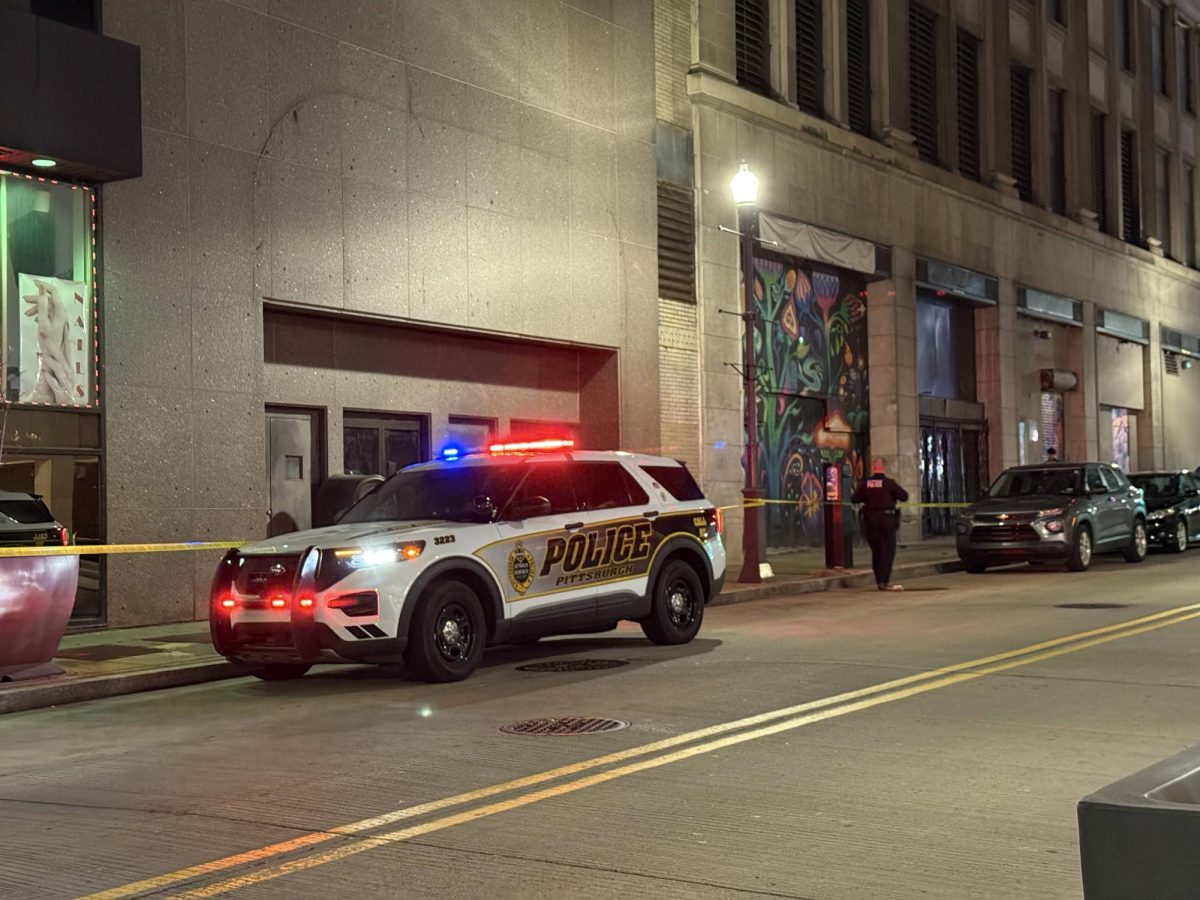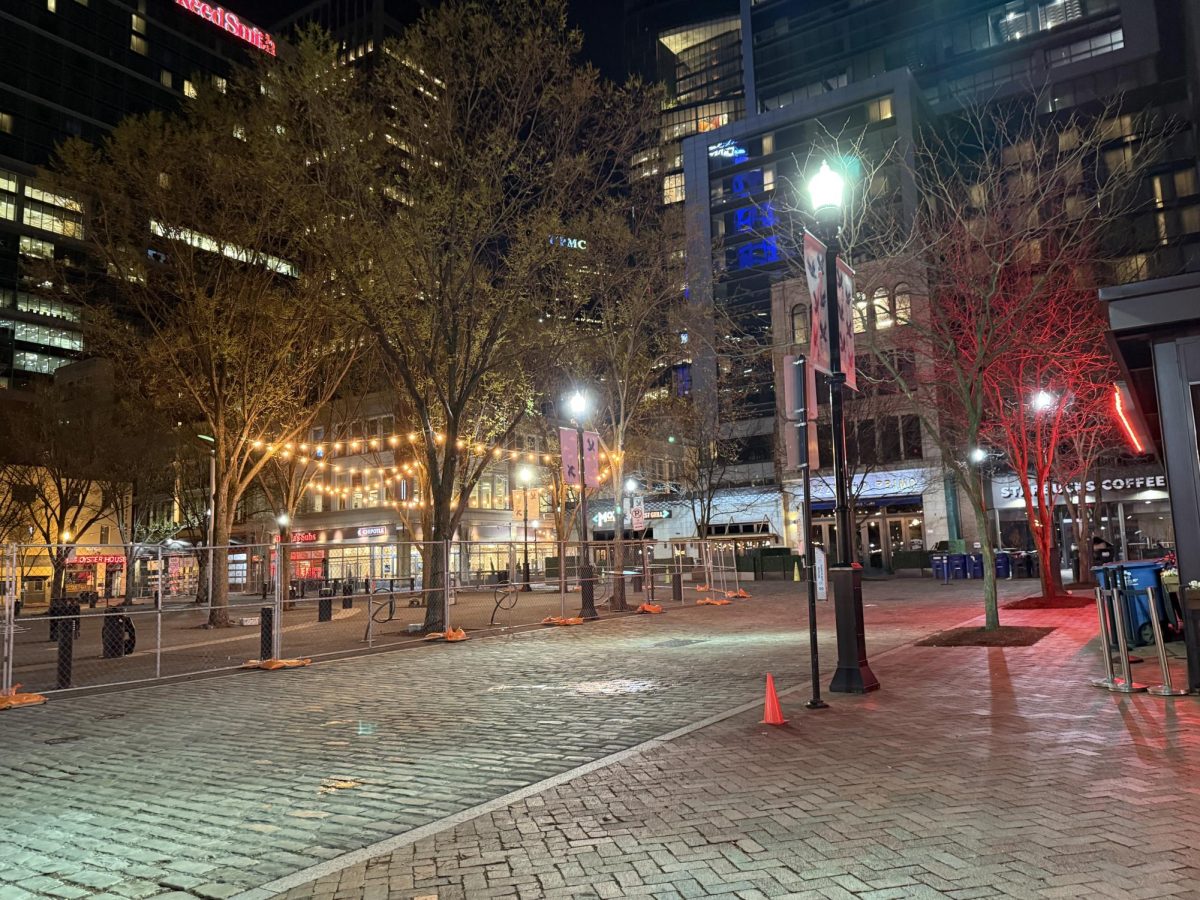
Photo by Rebecca Devereaux
Neal Swint, worker at CMG Media Venture installs and demonstrates the new touch screens in Academic Hall.
Point Park unveiled new interactive digital signage in the lobbies of several buildings on campus this week. The signs are located in the lobbies of Academic Hall, West Penn Hall, Lawrence Hall, University Center and Student Center.
“This has been in motion at least for a year, almost a year and a half,” said Chris Hill, vice president of Operations. “It was talked about previously a few years ago, but now we’ve looked at as something we need for the university.”
Hill, whose office deals with the physical day-to-day operations of Point Park, said that the digital signage was the answer to requests by staff, faculty, and students to “reduce clutter” with information distribution on campus.
“Right now, the system was put up pieces of paper throughout the university,” Hill said. “There was no real one location to go to that had information that a student says ‘I want to know whether we have an event or not. Where do I go?’ … These are now locations where you can go and get that information and what we’re now able to do is make it even far more than that.”
The signs are interconnected and display weather, an events calendar, and slides advertising upcoming university events as well as productions at the Pittsburgh Playhouse. There are buttons at the top for weather, directions, events, sports, and transportation.
“It’s basically limited by the amount of information you put in it,” Hill said. “That’s what we did. We bought the state-of-the-art [displays] to make sure that it did everything we wanted … We didn’t want just a TV scrolling.”
The wayfinding feature, under “directions,” allows students to choose from a list of campus buildings, affiliated locations such as the Playhouse, and points of interest to navigate to. Once selected, the screen highlights the route from your current building to that location.
Hill said that the next interactive feature will allow students to see in real-time the locations of university shuttles. It will give mapped locations of the shuttles’ current locations and approximate arrival times to their destinations.
The department of events and conference services will handle requests for displays on the digital signage. Each message appears in a rotation and the same rotation appears on every sign. Student organizations seeking to advertise follow the same procedure as they would for printing an events sign. Hill said that the Campus Activities Board will be the contact for student organizations seeking to advertise events.
The debut of the digital signage has met mixed reviews.
“I don’t understand the purpose of them, I just, I don’t like how my money was spent,” said senior forensic psychology major McKenna Adams.
Adams challenged Hill’s email to students which opened “In response to overwhelming requests from faculty, staff, and students,” and said she didn’t know who would have requested money to be spent in such a way.
“One of the things I hate [is] not being able to write a paper with the Wi-Fi and they bought this,” Adams said.
Not all reaction was negative, however. Freshman English major Rachel Truong, who has a story in this week’s issue of The Globe, said she liked the signage but was puzzled by the number of signs.
“I think it’s impressive, but I think that they have a lot of them, like it seems like there’s almost too many of them,” Truong said. “But I think it’s definitely something impressive, and I can see it being used in other colleges eventually if not already.”
Truong was impressed by the interactive features, especially the weather feature, and said that it would become particularly useful when deciding if a sweater or coat was necessary during the late fall months.
“I think it’s a good idea,” said Truong. “I think that they probably spent a little bit too much money on it because there are so many of them and I can’t even imagine how much one of them costs, however I think that they’re trying for the good of the student body.”
Truong said that the signage is also partic- ularly useful to student organizations advertising events.
“Everybody sees it walking in,” Truong said.
Freshman broadcast reporting major Sara Mackulin agrees that the signage is useful in getting information across quickly.
“I think it’s better than posting flyers everywhere. I think it’s definitely a way to draw people in and get them involved,” said Mackulin.
Mackulin said that fliers can be easily ignored and are too scattered sometimes to be effective. She said the display’s ability to broadcast information rapidly and in one central place was impressive.
“I don’t think it’s a waste of money because I think that actually people will see it and want to play with it,” Mackulin said.
Having a singular place to find information was the goal of the initiative. The interface and information will be fluid, but the infrastructure is in place to broadcast these messages.
“This is going to be ever-evolving,” said Hill. “You’re going to hit those buttons and those are [what is there for] now. You may come back after Christmas for example, and those buttons might be gone. It’s just a matter of trying to find out what’s best and that’s what we have out.”









